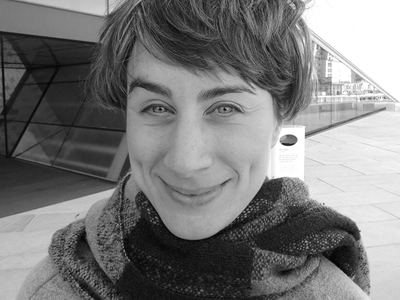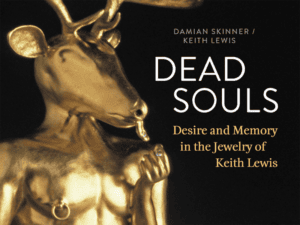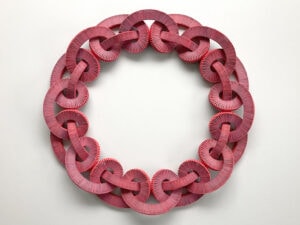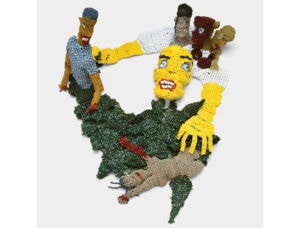
Second Hand, First Hand: Caroline Broadhead and Maria Militsi
October 14–November 14, 2015
Marsden Woo Gallery, London, UK
I’d like to begin this article with some bibbidi-bobbidi-boo. That is, “the thingamabob that does the job,”[1] or the magic that brings objects to life. Bibbidi-bobbidi-boo could be likened to Walter Benjamin’s notion of “aura,” to the “uniqueness” and “mystique” of the work of art as described in his The Work of Art in the Age of Mechanical Reproduction (1936); but it also comprises the fantastical, the transfusion of sparkle into things. I am, of course, making reference to Walt Disney’s Cinderella (1950), in which Cinderella’s dress is magically transformed from torn rags to haute couture just in time for her to make it to the ball; and it strikes me that artists Caroline Broadhead and Maria Militsi are our modern, magic-making equivalents.
Entering Second Hand, First Hand, the two artists’ recent exhibition at Marsden Woo Gallery, London, is like stepping into Cinderella’s scullery, with its barren concrete floor, bare wooden table and woven stool, and kitchen utensils strewn about. Yet a closer look reveals the creeping jewel-like texture of the space. There are echoes of J. G. Ballard’s 1966 novel The Crystal World, references to the encroaching crystallization of objects that “glistened like wedding-cakes,” and with “a ceaseless play of light” across their surfaces.[2] Broadhead and Militsi have rendered a performance in which the materials take center stage. These are not objects that merely provide the backdrop, but that have realigned themselves with the enchantment and allure of making.

It was Tatjana Marsden, director of Marsden Woo Gallery, who decided to bring the two artists together for Second Hand, First Hand. Broadhead is a doyenne of the UK applied arts scene. Having initially trained as a jeweler at the Central School of Art and Design, London—now called Central Saint Martins (CSM), London, where she is now program leader of BA jewelry design—her 40-year practice spans jewelry, textiles, and performance. She is the consummate maker, whose “relentless experimentation with ideas, materials, […] space and light” led Victoria Pomery to describe her practice as a “complex game of hide-and-seek”.[3] She is adamant that “disciplinary labels” are ineffectual, suggesting that jewelry is an “approach,” rather than a category of things.[4] This fluid attitude to making is evident in her work. Take, for example, her tufted, illusionistic Blue Rainbow bracelet (1978), recently exhibited as part of the Crafts Council’s touring exhibition I AM HERE (2015); or the irreverence of her Collapsing Chair (2011) exhibited in Taking the Chair, a joint exhibition with her daughter Maisie, also an artist, at Marsden Woo Gallery (2011); and the ghost-like structure of her Wobbly Dress (1990), which Broadhead describes as having an “unruly surface” and “ambivalent silhouette.”[5] Elements of these are visible in Second Hand, First Hand, and testify to the tenacity of Broadhead’s thinking. She has long been fascinated by the intrinsic ambiguity of the boundary—between interior and exterior, light and shadow, presence and absence—and it is this fluidity that infuses her practice. Added to this is the conscious recycling of ideas, which is something Broadhead actively promotes. She speaks emphatically about the importance of “looking back” over previous pieces, and rethinking ideas afresh. “I think you do foretell your own future,” says Broadhead. “This is why keeping sketchbooks of your drawings, or what you’re thinking about, is really important. I draw something as a doodle one year, and maybe 10 years later I’m making it and thinking, ‘God, that was exciting!’” Broadhead is a reflective and imaginative maker, whose impulse for renewal corresponds with the ambitions of Second Hand, First Hand: here, the pre-owned and the cast off are made anew.
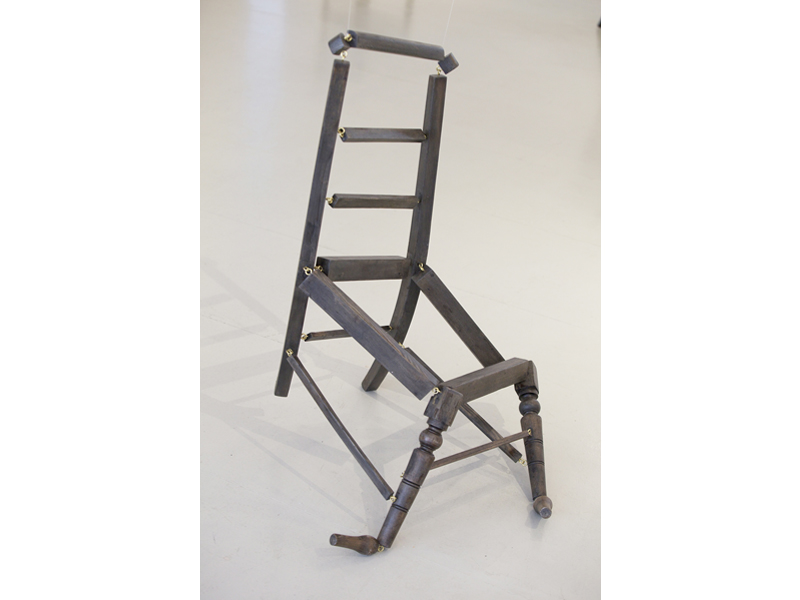 Militsi is the younger of the two artists, although the extent of her biography would suggest otherwise. She first trained at the Mokume School of Jewelry, Thessaloniki, Greece, before moving to the UK 12 years ago to continue her education at Middlesex University, and at the Royal College of Art (RCA), both in London. Like Broadhead, Militsi has exhibited worldwide, but it was her first solo show, Fragments of Memory (2011), curated by Tessa Peters in Marsden Woo’s former Project Space, that cemented her position within the contemporary jewelry scene. It comprised a collection of found crucifixes and their “doubles,” or impressions, re-created in the blind surfaces of cast silver amulets, and it consolidated familiar themes for the artist, such as memory, absence, and past traces. Militsi delicately upcycles her jewelry pieces, modifying ceramic figurines to spawn delicate silver “blossoms” that look like fondant scrolls; or attaching silver extrusions to junk-shop found objects that reimagine their missing parts. This recalls for me Martin Heidegger’s essay, The Thing (1950), in which he attempts to access the “thingness” of things, using the example of a ceramic jug, and decides that thingness, in fact, exists in the “void that holds,” in the empty space that enables the jug to hold. It is the self-same potency of the void that attracts Militsi, who describes her impulse to “embed value in discarded objects,” whether late-nineteenth century porcelain pin cushions or the dinky plastic shoes worn by dolls. Her additions of silverwork flesh out the ulterior lives of these objects.
Militsi is the younger of the two artists, although the extent of her biography would suggest otherwise. She first trained at the Mokume School of Jewelry, Thessaloniki, Greece, before moving to the UK 12 years ago to continue her education at Middlesex University, and at the Royal College of Art (RCA), both in London. Like Broadhead, Militsi has exhibited worldwide, but it was her first solo show, Fragments of Memory (2011), curated by Tessa Peters in Marsden Woo’s former Project Space, that cemented her position within the contemporary jewelry scene. It comprised a collection of found crucifixes and their “doubles,” or impressions, re-created in the blind surfaces of cast silver amulets, and it consolidated familiar themes for the artist, such as memory, absence, and past traces. Militsi delicately upcycles her jewelry pieces, modifying ceramic figurines to spawn delicate silver “blossoms” that look like fondant scrolls; or attaching silver extrusions to junk-shop found objects that reimagine their missing parts. This recalls for me Martin Heidegger’s essay, The Thing (1950), in which he attempts to access the “thingness” of things, using the example of a ceramic jug, and decides that thingness, in fact, exists in the “void that holds,” in the empty space that enables the jug to hold. It is the self-same potency of the void that attracts Militsi, who describes her impulse to “embed value in discarded objects,” whether late-nineteenth century porcelain pin cushions or the dinky plastic shoes worn by dolls. Her additions of silverwork flesh out the ulterior lives of these objects.
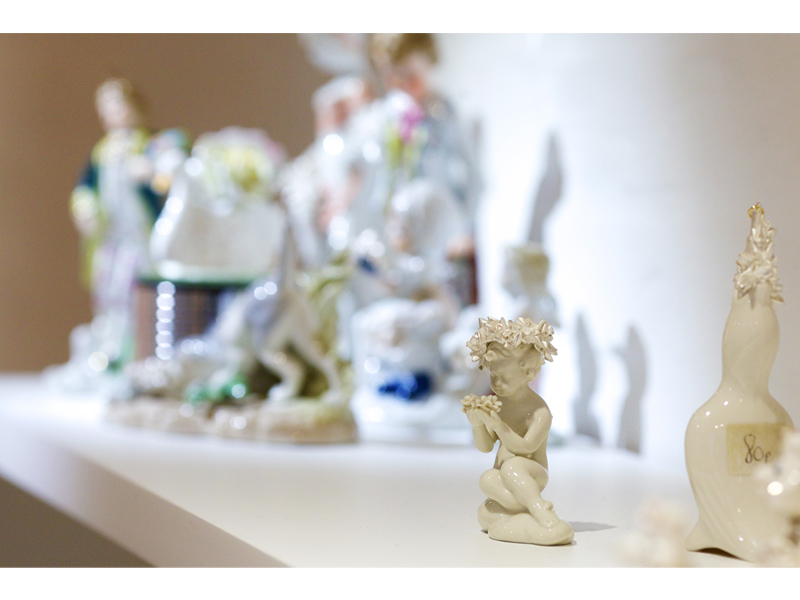
Militsi teaches alongside Broadhead at CSM, and shares her openness to jewelry practice, adding that “I’m trying to respond with an open mind to making, and this is what I would like the students to do—to not have preconceived ideas of what is right, or what is wrong.” Their interests extend beyond their teaching practices to narratives of the body, either long-lost, fictive, or yet to be found; to presence and absence; to material transformation and resuscitation; as well as to the social lives of things, in their value, circulation, and modification in different contexts. As Victoria Kelley states in the press release for Second Hand, First Hand, “Old and overlooked things have been found, and new things have been made, and the new and the old are in a knotty relationship to each other.”[6] I would suggest that this knottiness emerges in the relationship between small-scale and human-scale, threaded and welded, repetitive and supplementary—and, most of all, in the mesh of materiality with the shadowy world of the imagination.
Both artists worked independently toward Second Hand, First Hand, only coming together one month before the opening to discuss how best to exhibit the work. “I didn’t know what she was making, or the extent of what she was making,” remarks Broadhead, and “she only had an inkling of what I had been working on.” Neither had the curation of the exhibition been considered before then: “All we knew at that point was that we didn’t want to exhibit our work on plinths, so we just rooted around my house and found things that we thought would be suitable,” states Broadhead. Thus, the idea to stage a room setting grew organically. “There’s a fireplace at Marsden Woo,” says Broadhead, “which is such a strong indicator somehow of what should happen there.” Yet, curiously, it is the fireplace that feels most at odds in this mise-en-scène: There is a mismatch between the distressed wood and well-worn nature of the gallery-cum-scullery, and the austere white mantelpiece. That aside, the decision to drape, hang, and carefully choreograph their works within this “domestic” setting lends a sense of drama to the space, like a stage set charged with potential.
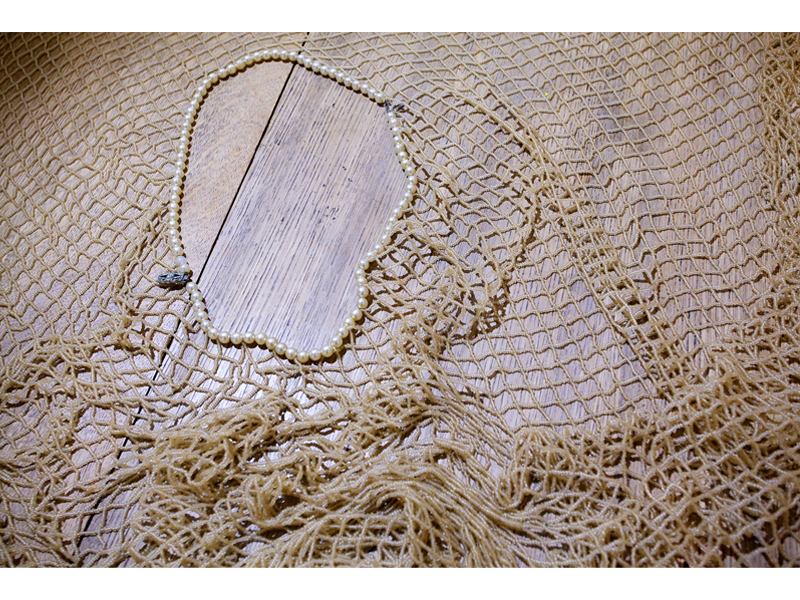
In the central space stands a solid oak drop-leaf table shrouded in folds of glass beads, punctuated with a pearl necklace. This is Broadhead’s Blanket for a Foundling (2014), first exhibited at The Foundling Museum in 2014, and here repurposed as a tablecloth, with the gathers and folds of intricate lacework. “It’s a blanket,” explains Broadhead, “and the double string of pearls opens out to form the neck. It has been stretched, and there’s a gapingness about it. It’s really about what’s missing.” There is both a sense of concealing and revealing in Blanket for a Foundling, which is a familiar trope for Broadhead, who, since encountering the meticulous beadwork of Mexican folk art in 2010, has reimagined and reinvented the edges and surfaces of everyday objects, such as chairs and stools. The textile method enables Broadhead to play with the silhouettes of objects, transforming their nature through this “soft-focus” approach. Likewise, Militsi homes in on the material absences that, nevertheless, constitute the object, which she reimagines as the object’s “memories.” Nutgrater (2015) is a rusted tin utensil fixed to the wall that resembles a stoup, or basin for holy water, discreet and unobtrusive. Yet look away for a second and it glistens momentarily; the small rasped holes of its surface studded with tiny diamonds that recall the remnants of afore-grated nutmeg. It’s as if these objects, like Ballard’s crystals, are slowly regaining their composure, and that, if left alone for too long, they will gleam, flicker, and flare into life. “We now know that it is time,” writes Ballard, “Time with the Midas touch,’ […] which is responsible for the transformation,”[7] and here in the petrified space of the exhibition, there is the glint of life in these tiny diamonds.
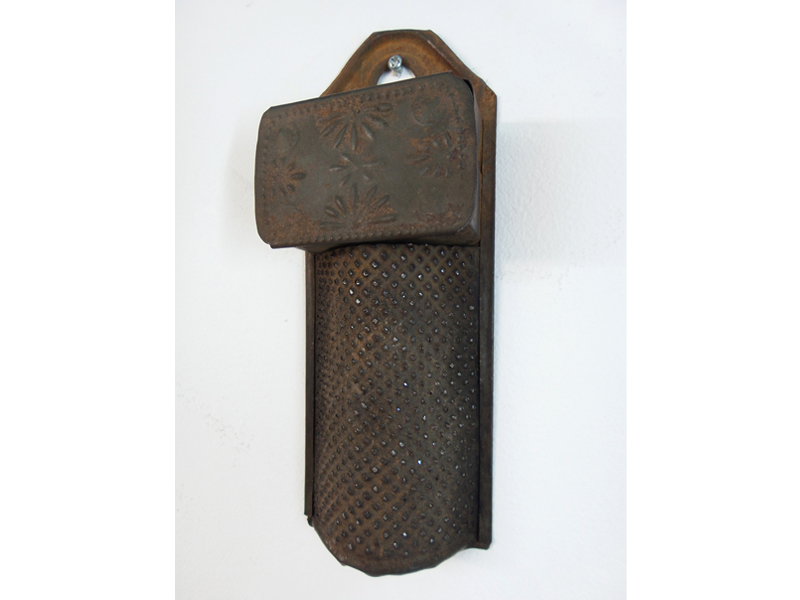 Still Life, Stool and Still Life, Shadow (both 2015) are Broadhead’s interpretation of this slippage between truthfulness and make-believe. The former imagines a light source on the beaded stool, in a pattern of gold and black beads that contrasts with the logic of its cast shadow. The latter reverses this relationship, and translates a beaded shadow on the floor, while its material counterpart, the stool, is absent. “I call both those pieces Still Lives,” remarks Broadhead, “because it’s about stilling that shadow, or fixing it, and I’ve made quite a lot of things along those lines. For me, it is about arresting the moment; like in a photograph or a painting, where you’re stopping something.” This leads me to ask about what the shadow represents for Broadhead. “This is an on-going concern for me,” she states. “I have used the shadow to represent the darker side of somebody; there’s the shadow of the person, but also that kind of slightly unknown, or doubling up of something, of the ‘other.’ But I think a shadow is slightly mysterious, and there’s a distortion when it’s translated into the two-dimensional.”
Still Life, Stool and Still Life, Shadow (both 2015) are Broadhead’s interpretation of this slippage between truthfulness and make-believe. The former imagines a light source on the beaded stool, in a pattern of gold and black beads that contrasts with the logic of its cast shadow. The latter reverses this relationship, and translates a beaded shadow on the floor, while its material counterpart, the stool, is absent. “I call both those pieces Still Lives,” remarks Broadhead, “because it’s about stilling that shadow, or fixing it, and I’ve made quite a lot of things along those lines. For me, it is about arresting the moment; like in a photograph or a painting, where you’re stopping something.” This leads me to ask about what the shadow represents for Broadhead. “This is an on-going concern for me,” she states. “I have used the shadow to represent the darker side of somebody; there’s the shadow of the person, but also that kind of slightly unknown, or doubling up of something, of the ‘other.’ But I think a shadow is slightly mysterious, and there’s a distortion when it’s translated into the two-dimensional.”
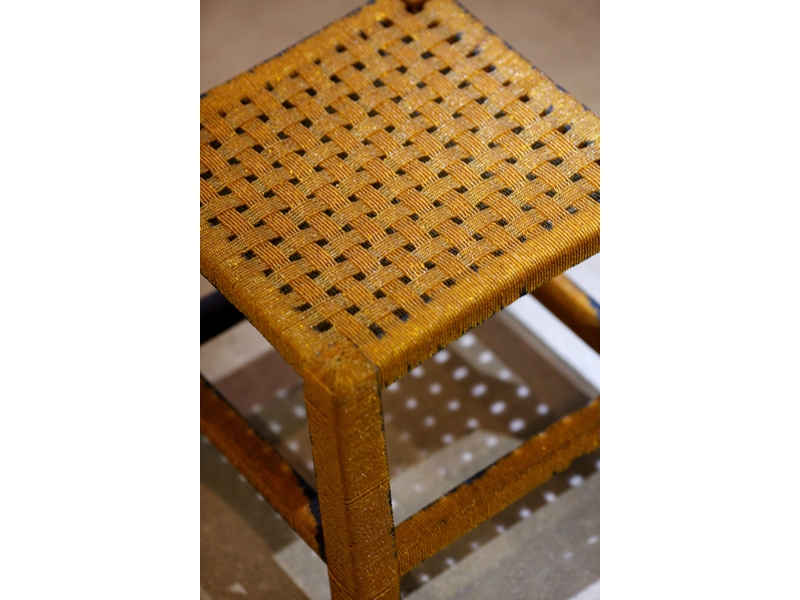
The shadow is significant for Militsi, too. Colander (2015) is a well-worn tin colander studded with silver earrings in a flower formation that hangs at the entrance to the space. It twists and spins under an intense white spotlight, which casts a majestic silhouette on the wall. Yet, what is most unsettling about this quasi-moon is its ambiguous shadow, which shares the roundness of the colander, but appears distorted and incongruent. It has the sharpness of a shadow-puppet, the surreality of the Brothers Grimm, and the “unhomeliness” of Freud’s uncanny.[8] On the opposite wall is a similar kaleidoscope of light. Nestled among Militsi’s altered figurines is a ceramic swan that sits atop a mirrored music box, casting splinters of light as it spins. I put it to Militsi and Broadhead that Second Hand, First Hand emphasizes the other-worldliness of things, and how, for me, it evokes the transformative aspect of Cinderella. “I think that’s a good analogy,” comments Broadhead. “The colander is a very workaday thing, and it has clearly had its day! Then there’s this little glint of glamour attached to it. So I think Cinderella, and the notion of transformation, is fitting.” “Yes,” adds Militsi. “Suddenly these objects have a presence. They’re staged, they’re lit up, and they have all this drama around them. And especially the colander, which has been studded with earrings to produce a flower shape, yet that isn’t visible in its shadow.”
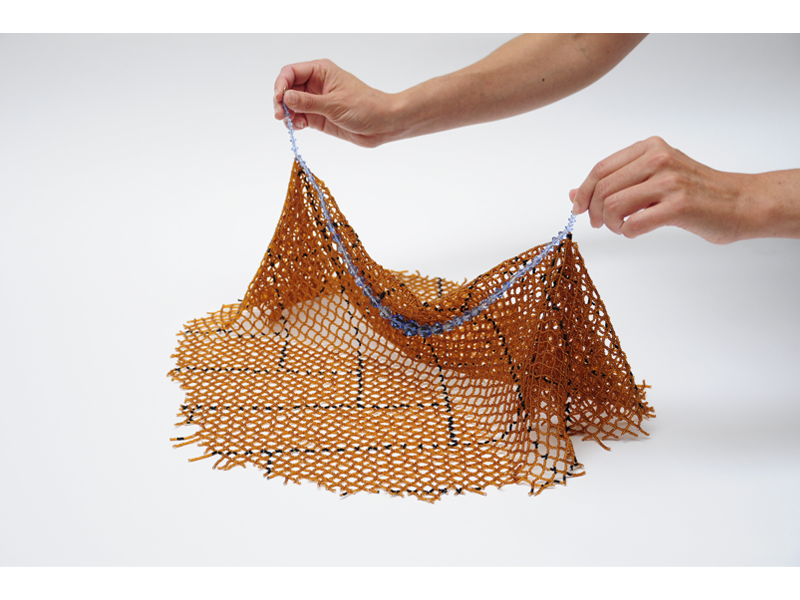
This doubling, and sense of surrealism, is also apparent in the split-second shift between the autonomous object and wearable jewelry. Broadhead’s Dropped Necklace (2015) resembles a beautiful torn fragment of an Aztec rug, on which a pearl necklace lies forgotten, as if it had slipped unnoticed from its wearer’s neck. Yet the necklace has been carefully attached to the beaded fragment along its center line, so it can be picked up and worn as jewelry. “I was thinking about how things affect one another,” explains Broadhead. “In my narrative, the necklace has fallen on the floor, and when you go to pick it up, you also pick up the carpet.” Broadhead has produced similar textile pieces before, such as her Parquet Floor Necklace (2014), and again, it’s that slippage between idea and object, two-dimensional and wearable, that makes her work so suggestive. “I think the aim is to bring in that element of the unknown”, suggests Broadhead. “It doesn’t always work, but it’s that bit of magic. It is about creating something that has an added dimension to it.” So, is it about that moment of reflection? Broadhead agrees: “Yes. If the object is successful there is that interaction; it’s about a second look, or a thought process, or an association that follows on from seeing it.” She continues, “For instance, being able to handle something like Maria’s pendant, there’s a physical interaction, where you decide how to wear it, put it back, play with it. I think it’s that level of involvement that you ideally want.” Broadhead is describing Militsi’s ceramic figurines embellished with silver scrolls, such as Bird Funnel (2015) and Kikuko (2015), that can be detached and worn as separate pieces. And for Militsi, this marks a point of contact between both artists’ works: “I think the common thread in the exhibition is how idiosyncratic the pieces are,” she states, “because they need to be treated in very particular ways. With my work, if you try to remove some of those clusters—those lumps of metal—you wouldn’t be able to put them back again. You almost need to have a manual to know how to do it! It’s as if the objects have their own lives.” Militsi’s objects, then, have this transformative aspect, wavering between pure ornament and wearable jewelry, although, as she acknowledges, there is an awkwardness, or resistance, in them. Her silver embellishments retaliate, whereas Broadhead’s textile pieces seem more acquiescent.
 If there is one work in Second Hand, First Hand that, for me, evokes the potency of material transformation, and that explicit sense of bibbidi-bobbidi-boo, it is Broadhead’s Reconditioned Stool (2015). Positioned near the back of the gallery space in a heap on the floor is a pulsing, efflorescent white mass of sliced wood and linen threads. The compelling narrative of Reconditioned Stool unfolds the more time one spends with it, much like Louise Bourgeois’s Spider (1996), which led Mieke Bal to describe it as a “theoretical object.”[9] Broadhead was looking for a stool that was “sturdy,” “covered in paint,” and “preferably white,” which she eventually tracked down on eBay. She meticulously divided it into small, modular units—much like her beadwork—and then painstakingly rebuilt it, stringing each wooden cube, one by one, on white thread. The mycelia-like threads form a network of fine white filaments across the work, softening its contours and rendering it indistinct. “The decision to leave the threads attached was the antithesis to the other, more neat works,” says Broadhead. “Actually, I couldn’t decide on how to get rid of the ends, but then I realized that I quite liked that notion of extension; of something spreading, almost like a kind of fungi. It was a collapsed object, so it was quite pitiful, but quite funny as well.” Reconditioned Stool recalls the absurdity of her collapsible and illusionary chairs exhibited in Taking the Chair (2011); there is a woodenness, as well as animation, to it, where the real and the imaginary interweave.
If there is one work in Second Hand, First Hand that, for me, evokes the potency of material transformation, and that explicit sense of bibbidi-bobbidi-boo, it is Broadhead’s Reconditioned Stool (2015). Positioned near the back of the gallery space in a heap on the floor is a pulsing, efflorescent white mass of sliced wood and linen threads. The compelling narrative of Reconditioned Stool unfolds the more time one spends with it, much like Louise Bourgeois’s Spider (1996), which led Mieke Bal to describe it as a “theoretical object.”[9] Broadhead was looking for a stool that was “sturdy,” “covered in paint,” and “preferably white,” which she eventually tracked down on eBay. She meticulously divided it into small, modular units—much like her beadwork—and then painstakingly rebuilt it, stringing each wooden cube, one by one, on white thread. The mycelia-like threads form a network of fine white filaments across the work, softening its contours and rendering it indistinct. “The decision to leave the threads attached was the antithesis to the other, more neat works,” says Broadhead. “Actually, I couldn’t decide on how to get rid of the ends, but then I realized that I quite liked that notion of extension; of something spreading, almost like a kind of fungi. It was a collapsed object, so it was quite pitiful, but quite funny as well.” Reconditioned Stool recalls the absurdity of her collapsible and illusionary chairs exhibited in Taking the Chair (2011); there is a woodenness, as well as animation, to it, where the real and the imaginary interweave.
I would suggest that what merges Broadhead and Militsi’s practice is time: time to look, reflect, make, and remake; the slippage between the lived time of experience, and the make-believe of fabrication; and the biographies of objects, their past lives and present manifestations. “The work I have produced for this show,” remarks Militsi, “is work-in-progress: nothing is fixed, and although it relates to previous work, and although it’s repetitive in places, it’s as if everything is ongoing.” Like Broadhead’s uncut linen threads that extend beyond the surface of her Reconditioned Stool, Second Hand, First Hand provides a snapshot of contemporary jewelry, but one that continues to unravel.
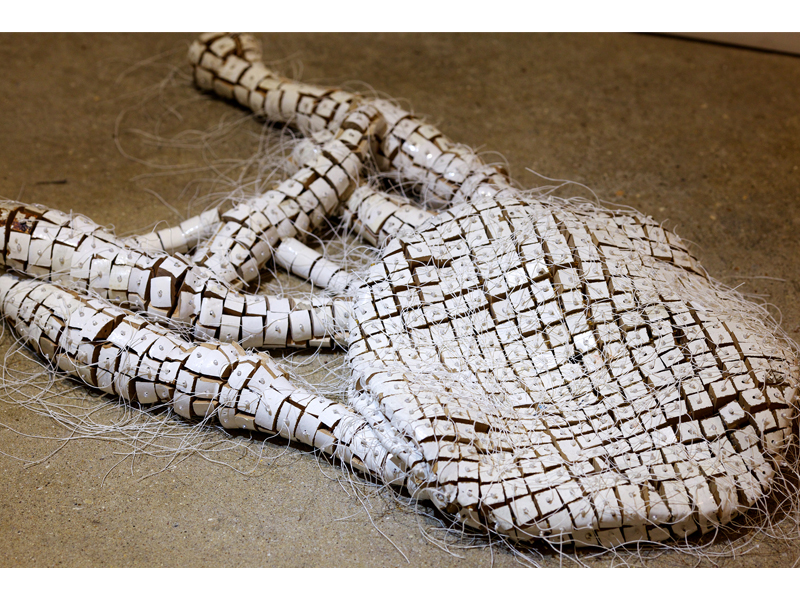
[1] “Bibbidi-Bobbidi-Boo,” Walt Disney’s Cinderella, 1950.
